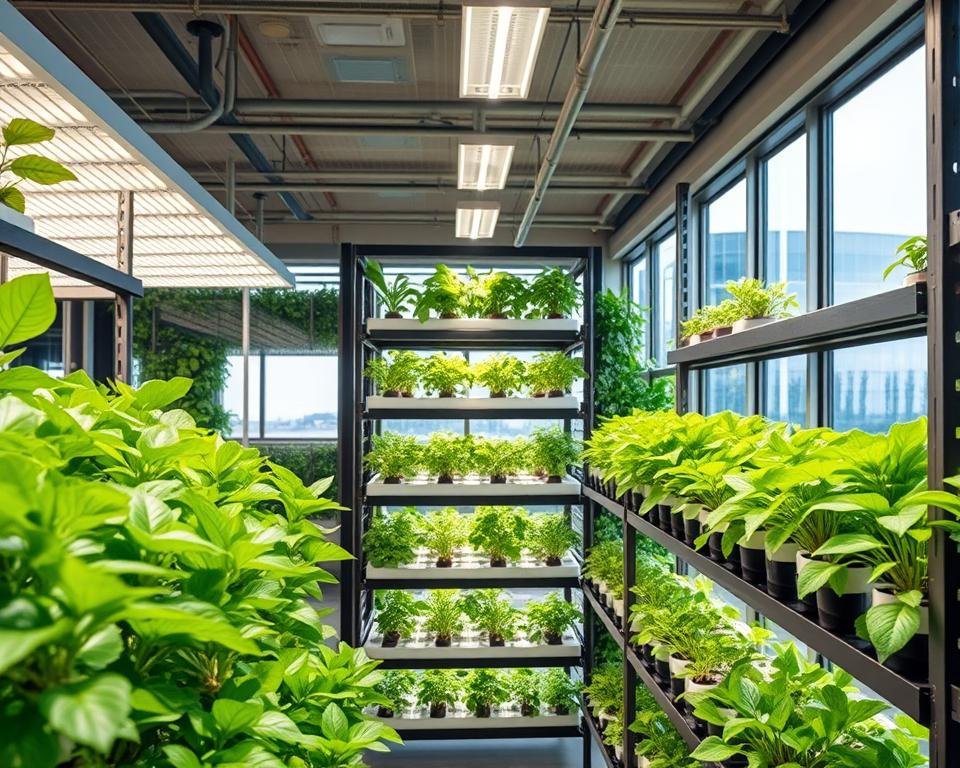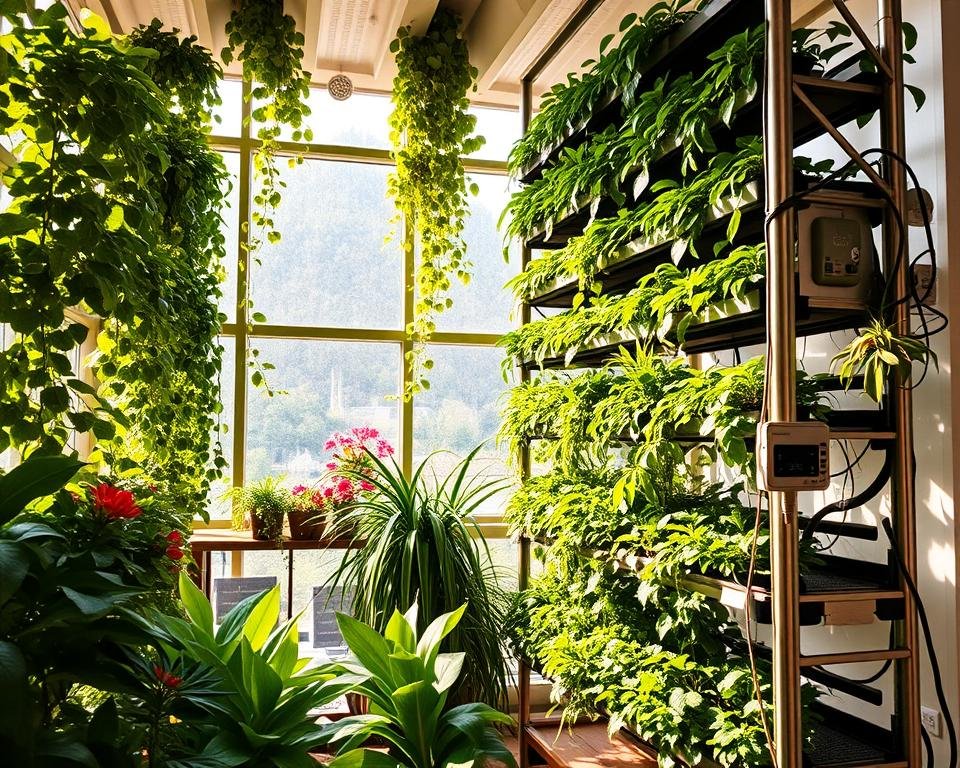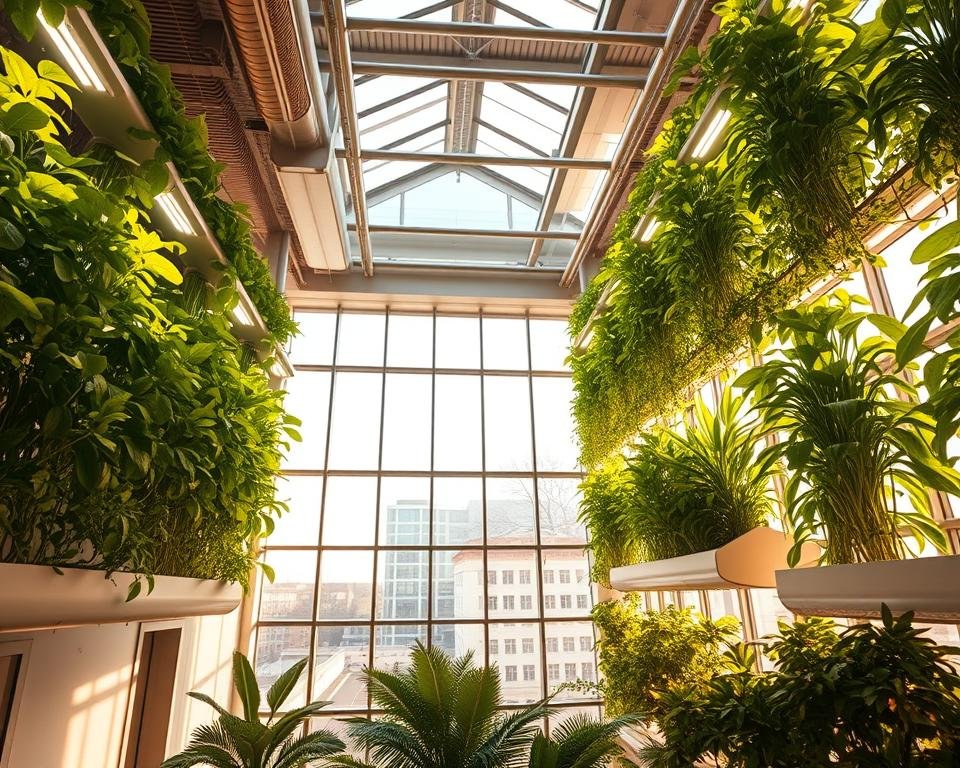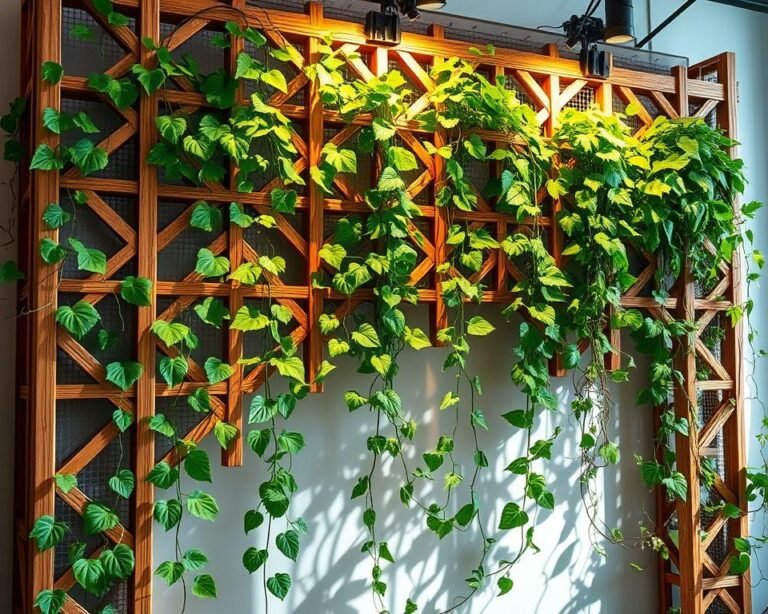Climate-Controlled Vertical Gardens: Perfecting Indoor Environments
Growing your own food used to seem impossible in cities. Now, climate-controlled vertical gardens are changing that. They turn empty spots into green, productive areas right in our homes and cities.
Picture this: picking fresh lettuce or strawberries from your kitchen wall, any time of year. Vertical farming makes this real, growing 10 to 20 times more food per acre than old ways. Companies like Oishii are leading this change, growing strawberries that are incredibly fresh and tasty.
These indoor gardens are more than just places to grow food. They offer a green way to make food, even in cities with little land for farming. With advanced climate control, vertical gardens can grow food perfectly all year.
Key Takeaways
- Vertical gardens maximize crop production in limited spaces
- Climate-controlled environments enable year-round growing
- Innovative farming techniques reduce water and energy consumption
- Urban agriculture becomes accessible through vertical farming
- Sustainable food production is now possible in indoor settings
Understanding Vertical Garden Systems
Vertical gardens are a new way to grow food in cities. They stack plant containers up high, saving space and making farming more efficient. Vertical farming technology is changing how we grow food, from small apartments to big farms.
There are many types of vertical garden systems for different needs and spaces. Let’s look at the main ones:
- Living Walls: Aesthetic vertical gardens integrated into building structures
- Green Panels: Modular systems allowing flexible plant arrangement
- Hydroponic Solutions: Soil-free growing methods using nutrient-rich water
- Compact Vertical Structures: Space-efficient designs for urban settings
Living Walls and Green Panels
Living walls turn indoor spaces into green havens. They cut down on energy costs, improve air quality, and look amazing. Architects and designers are adding them to buildings to make them more sustainable.
Hydroponic and Soil-Based Solutions
Hydroponic vertical gardens are great for indoor farming. They can grow 10 times more food per square foot than traditional farming. They use 98% less water and need much less land.
| Growing Method | Water Usage | Crop Yield | Space Efficiency |
|---|---|---|---|
| Traditional Farming | 100% | Standard | Low |
| Vertical Hydroponic | 2% | 10x Higher | Very High |
Modular Garden Structures
Modular vertical garden systems are flexible for homes and businesses. You can change them to fit your needs, from herbs to veggies. They let you create your own indoor garden.
Essential Components of Indoor Vertical Gardens
Creating a successful indoor vertical garden needs careful attention to several key components. These components support plant health and growth. Your indoor environment is crucial for the success of these innovative gardening systems.
The main elements of an effective vertical garden include:
- Advanced HVAC systems for precise climate control
- Sophisticated lighting solutions
- Precise irrigation and nutrient delivery methods
- Air circulation and indoor air quality management
Lighting is a key part of indoor vertical gardens. LED grow lights can greatly improve plant growth. They can increase growth rates by up to 50%. These lights are great for indoor spaces with little natural sunlight, ensuring plants get the right amount of light.
HVAC systems are vital for the perfect indoor environment. They help control:
- Temperature
- Humidity levels
- Air circulation
- Carbon dioxide concentration
Advanced vertical gardening techniques can greatly improve indoor air quality. Studies show that about 90% of indoor plants help filter toxins and release oxygen. This makes living spaces healthier. By designing your vertical garden well, you can reduce indoor pollutants and create a beautiful green space.
Irrigation systems are also very important. Modern hydroponic systems can use up to 90% less water than traditional gardening. Automated irrigation delivers water precisely, cutting down on waste and keeping plants healthy.
Climate-Controlled Environment Management
To create the perfect indoor garden, you need to control the environment well. Learning about climate management can turn your space into a lush, thriving garden.

Vertical gardens need good temperature and humidity control. The health and growth of your plants depend on these conditions.
Temperature Regulation Systems
Keeping the right temperature is key for plants to grow well. There are many ways to control the climate:
- Central heating and cooling systems with smart ducts
- Smart climate control with automatic settings
- Hybrid systems using gas and electric heat
- Geothermal heat pumps that use underground heat
Humidity Control Methods
Managing humidity is important to stop diseases and help plants grow strong. Here are some ways to do it:
- Digital systems to check humidity levels
- Moisture control built into the system
- HEPA filters to keep the air clean
Air Circulation Requirements
Good air flow is vital for strong plants and to avoid stale air. Here are some ways to improve air flow:
- Placing ventilation units wisely
- Using both passive and mechanical air systems
- Setting temperature controls for each room
| System Type | Temperature Control | Energy Efficiency |
|---|---|---|
| Central HVAC | Comprehensive | Moderate |
| Mini-Split Systems | Targeted | High |
| Geothermal | Consistent | Very High |
Using these advanced methods keeps your garden healthy and vibrant. Invest in good climate control systems for better plant health and growth.
Smart Technology Integration and Automation

Modern vertical gardens are changing indoor growing with smart tech. This tech makes gardening easier and more precise. It lets you control complex growing spaces with ease.
Smart tech makes gardening super convenient. Your garden can be managed with smart systems. These systems watch over your garden and make adjustments as needed.
These smart systems offer many benefits:
- Real-time environmental monitoring
- Automated watering and nutrient delivery
- Remote climate control via smartphone apps
- Energy efficiency optimization
IoT devices and sensors are key in these smart gardens. They can predict and meet plant needs before you even have to think about it. For example, sensors can check moisture, adjust lights, and control temperature all by themselves.
Energy saving is a big part of these new techs. Smart gardens use up to 30% less energy than old-school gardens. AI helps manage resources, so plants grow well and waste is cut down.
“They’re boxes that connect to the internet and with a couple taps of your phone, you tell them what kind of food you want to grow and how to do it, and it will do the rest,” explains agricultural technology expert.
By using smart tech, your vertical garden becomes efficient and easy to care for. It gives great results with little effort from you.
Sustainable Growing Practices in Vertical Gardens

Urban agriculture is changing how we grow food with new, green designs. Vertical gardens are a big step forward in farming. They help solve big problems in modern farming. Vertical farming techniques are making it possible to grow food in small spaces.
Water Conservation Strategies
Water saving is key in vertical gardening. New systems use much less water, sometimes 98% less than old farming ways. Important water-saving methods include:
- Closed-loop water recycling systems
- Atmospheric water collection
- Precision irrigation technologies
- Condensation capture from plant leaves
Energy-Efficient Lighting Solutions
Using less energy is important in vertical gardening. LED grow lights are changing how we grow plants indoors. They use very little energy but work well. Some new ideas include:
- LED lights with 2.9 µmol/J efficiency
- Solar-powered growing systems
- Smart light spectrum management
- Natural light maximization techniques
Waste Management Innovations
Handling waste well is key in vertical gardening. New systems aim to cut down waste and make closed-loop systems. This helps protect the environment.
| Waste Management Technique | Environmental Benefit |
|---|---|
| Organic composting | Reduces waste by 90% |
| Biodegradable material use | Minimizes landfill contribution |
| Nutrient recycling | Eliminates chemical waste |
By using these green practices, vertical gardens show how tech can make urban farming better for the planet and very efficient.
Maximizing Crop Yield and Quality
Vertical gardens change how we grow food indoors by controlling the environment precisely. You can now get amazing crop yields that beat traditional farming. Using advanced CEA methods, your vertical garden can become a top-notch growing space.
Here are some key ways to boost crop production:
- Precise temperature management between 65°F and 75°F
- Optimized humidity control to prevent plant stress
- Advanced nutrient delivery through hydroponic systems
- Strategic LED lighting for consistent growth cycles
The comfort of your plants affects their growth. CEA systems can grow up to 13,000 plants at once, with harvests every 6-8 weeks. These new methods use 95% less water than old farming ways.
| Crop Performance Metrics | Traditional Farming | Vertical Garden CEA |
|---|---|---|
| Water Usage | High Water Consumption | Up to 95% Water Reduction |
| Harvest Frequency | Seasonal Limitations | Every 6-8 Weeks |
| Crop Yield | Standard Production | 10-20x More per Acre |
Your indoor vertical garden can be a leader in farming innovation. It can produce consistent, high-quality food while being kind to the environment. By using smart tech and climate control, you’ll make a perfect place for growing crops.
Conclusion
Vertical gardens are changing how we grow food in cities. They turn small indoor spaces into green, growing areas. This uses special climate control to grow more food with less harm to the environment.
Vertical gardening goes beyond old farming ways. It lets you grow food all year, no matter the weather outside. With the right climate control, plants thrive even in tight city spots.
As the weather gets wilder, vertical gardens are a bright spot. They’re a smart way to farm in homes, restaurants, and public areas. By using these systems, you help local food grow, save on shipping, and support a greener future.
Choosing vertical gardens means joining a worldwide effort for better food and planet care. By adding these systems to your space, you help make food more secure, protect the environment, and make cities stronger.







